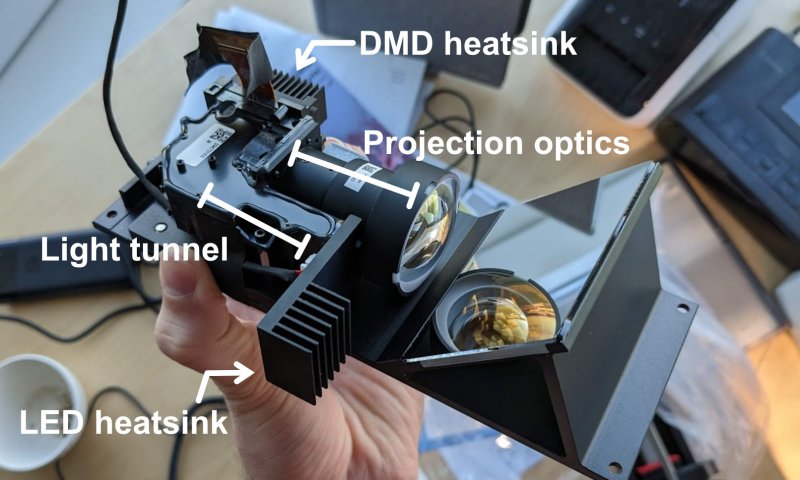Inspired by the idea of creating a maskless lithography system using a digital micromirror device (DMD), [Nemo Andrea] tore into an Anycubic Photon Ultra, DLP & resin-based 3D printer to take a look at its projector system. Here Anycubic isn’t the maker of what is called the ‘optical engine’, which would be eViewTek’s D2 projector and its siblings. This projector assembly itself is based around the Ti DLP300s, which we covered a while back when it was brand new. Since that time Anycubic has released the Photon Ultra and Photon D2 3D printers based around these optical engines.
 Using DMD for lithography isn’t a new thing, as [Nemo] points out, referencing the μMLA system by Heidelberg Systems. What would be new is using a freely available and rather affordable DMD (even if it requires sacrificing a 3D printer) to obtain its optical engine in order to create an open and more affordable lithography platform than commercial ‘contact us for a quote’ option.
Using DMD for lithography isn’t a new thing, as [Nemo] points out, referencing the μMLA system by Heidelberg Systems. What would be new is using a freely available and rather affordable DMD (even if it requires sacrificing a 3D printer) to obtain its optical engine in order to create an open and more affordable lithography platform than commercial ‘contact us for a quote’ option.
No doubt it’s a challenging project, but perhaps the nice side effect of having affordable DLP 3D printers out and about is that their DMDs are now also significantly more accessible than they were previously. We wish [Nemo] all the best in this endeavor, as a maskless lithography machine would be just that addition to any hobbyist’s toolset that we are no doubt waiting for.
(Thanks to Jerry for the tip)
















That’ll be the next story about all the IP-less chip designs one can create.
Yeah RISC-V chips will be taking off image getting live updates of a chips feature set and being able to print a new one.
Curious what protocol the FPC cable on the optical unit speaks, whether it’s something proprietary or easy to interface with.
The FPC to the DMD unit itself is probably following the instructions/trouting from TI to the letter (haven’t checked it yet). The signals that need to go to the DMD are very specific to the physics of the actual mirror units (as far as I understand) so it really isn’t an option to generate these manually. At any rate, the DLPC1438 and DLPA2005 together are less than half the price of the DMD unit, so I personally also do not see much use in bypassing them.
Quite proprietary. LS pins send command like when to flip the mirrors and the HS pins send the actual image data. But the details are pretty complicated. It’s not really feasible to drive a DMD without a TI proprietary controller.
The really neat thing about these DLP300S/301S DLP chips and their supporting chipsets is pretty much the only thing I haven’t been able to find on a site with an “add to cart and buy” option is the interposer socket for the DLP chip, and even that I’m sure is available somewhere, or can be made, in qty 1-10. I believe TI recommends the ones made by neoconix but they’re a “request a quote” company. Everything else can be bought either directly through TI or on Digikey or Mouser in qty 1-10 for relatively cheap.
I’ve considered making my own board for these for pretty much the same purpose. The biggest issue is just that the controller chip is BGA and all I have for reflow is a cheap Target hotplate and a ceramic tile :/
Besides the interposer, you’d need some custom mechanical housing to get everything to sit into place and make a reliable electrical connection. Pretty tricky to do anything so it’s often easier just to cannibalize from brown gear. DLP is not a very accessible technology.
Hmmph. Anycubic says the Photon Ultra is available only in the EU. Darn. Terrific sale on it now.
Anyone knows what is the purpose of the micro-HDMI on the D2 motherboard? Could that be used to connect to a PC and project the display?
Anyone knows the purpose of the micro-HDMI port in the photon D2 motherboard? Can I project from a PC?